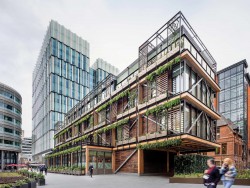As global leaders grapple with issues surrounding climate change, the world is gradually coming together to develop strategies to help alleviate the impact of global warming. Here, Andy Goodwin, Managing Director of B&K Structures, shares how we can effectively lock up carbon and maximise the benefits of engineered timber technology in the construction industry.
While the climate crisis can feel like a huge, abstract issue to successfully resolve, we all have a responsibility to contribute to a better, more sustainable environment. Until recently, the benefits of carbon sequestration were not widely discussed. But with growing concern around environmental health, this term is now more widely understood.
Responsibly sourced timber has the capability to vastly reduce our dependency on concrete, decreasing global carbon emissions by 4-8%. Engineered timber builds boast environmental benefits both in terms of raw materials and the numerous advantages associated with offsite construction. In fact, using timber as a core structural component for developments across all sectors is already capturing over one million tonnes of CO2 through carbon sequestration every year.
Carbon sequestration describes the long-term storage of carbon dioxide (CO2) to mitigate global warming and avoid dangerous climate change. The natural process of carbon sequestration which occurs in trees enables each cubic metre of timber to store circa 900 kg of CO2 and hold captive during its entire lifetime, even when it has been processed for use in construction.
Solid wood products, such as cross laminated timber (CLT) are natural and far less energy-intensive to produce and apply than alternative structural materials. Not only is it renewable, but the production process also creates minimal waste and all offcuts are recycled. For every cubic metre of CLT manufactured, 676 kg of CO2 will still be stored.
The overall carbon footprint for a CLT building is lowered by up to 75%. A typical medium rise engineered timber development has the ability to lock up 19 tonnes of CO2. It is estimated that a single five-storey CLT building is able to cut emissions by levels equivalent to removing as many as 600 cars from the road for a year.
We are not engineered timber purists. Our business model focuses on hybrid construction solutions. However, cross laminated timber is by far the most exciting revolutionary building material that will be significant in our future development plans.
The innovative use of sustainable materials, such as cross laminated timber can help to deliver high-quality, high-density buildings without compromising the environment. I firmly believe it is important to raise awareness of how carbon sequestration and structural timber technology can contribute to reducing carbon emissions.
The UK has a magnificent heritage of timber architecture dating back to the thirteenth century. We are now building on this legacy using ground-breaking engineered timber systems to create a more sustainable future for generations to come.
Image: 02 The Pavilion Manchester - Photo Credit Sheppard Robson LR









